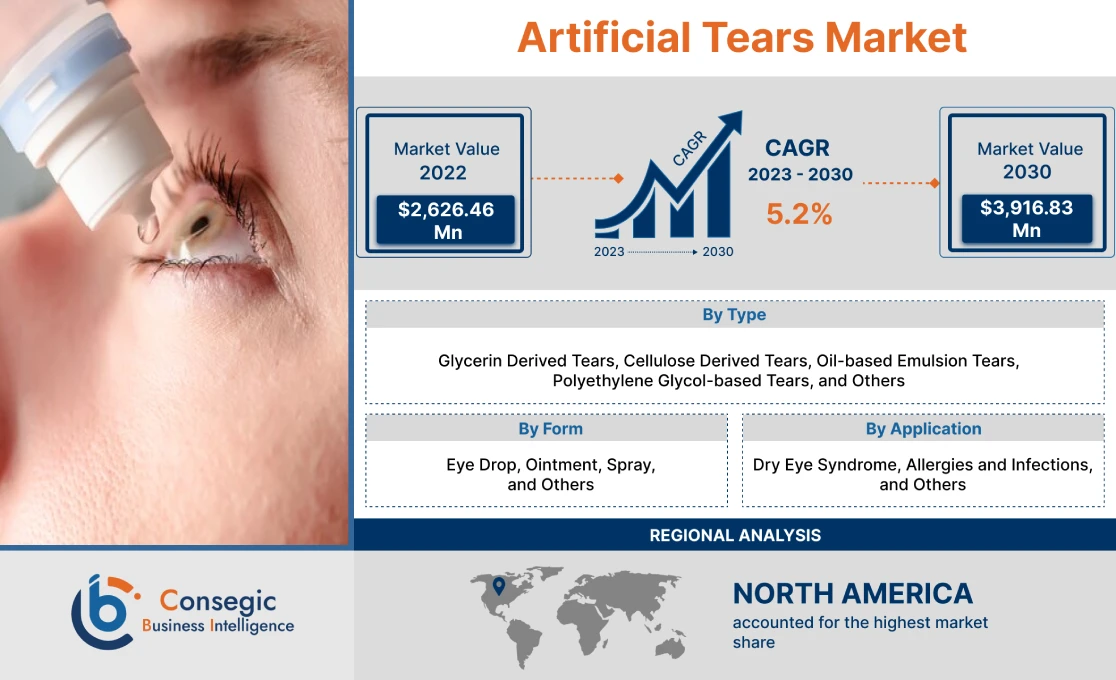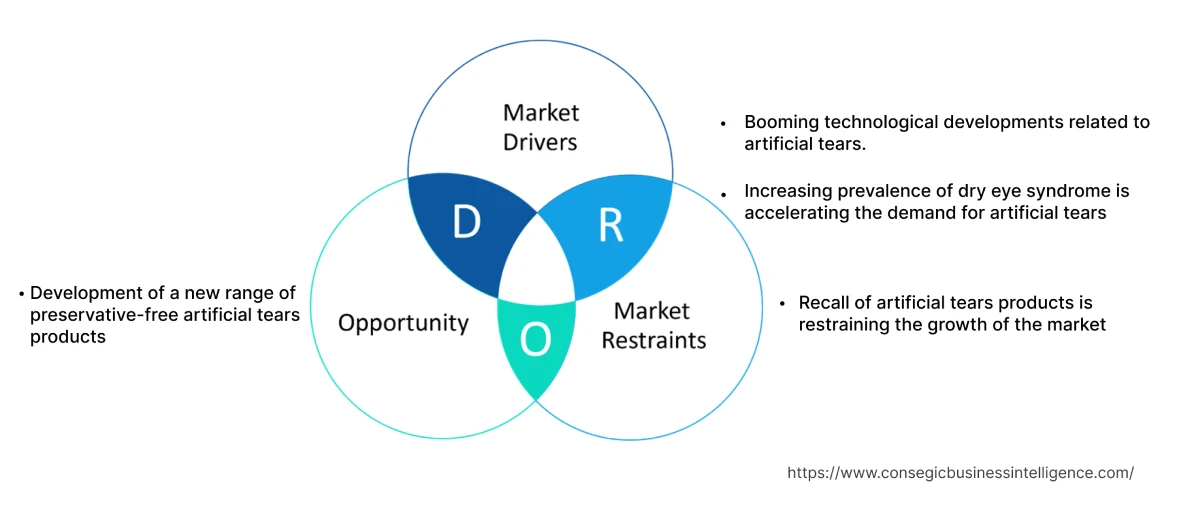Artificial Tears Market Size :
Consegic Business Intelligence analyzes that the Artificial Tears market size is growing with a healthy CAGR of 5.2% during the forecast period (2023-2030), and the market is projected to be valued at USD 3,916.83 Million by 2030 from USD 2,626.46 Million in 2022.
Artificial Tears Market Scope & Overview:
Artificial tears refer to eye drops that are utilized to lubricate dry eyes and help in maintaining moisture on the outer surface of the eyes. There are two categories of these tears, including eye drops with preservatives and preservative-free eye drops. Furthermore, several synthetic tears, including glycerin-derived tears, cellulose-derived tears, and others, are used by consumers to reduce tear evaporation. Also, as per the analysis, these tears may contain thickening agents. The thickening agent aids in keeping the solution on the surface of the eyes for a longer duration. These tears are majorly utilized in dry eye syndrome, allergies, and infections, among other applications.
Artificial Tears Market Insights :
Artificial Tears Market Dynamics - (DRO) :
Key Drivers :
Booming technological developments related to artificial tears
Global players in the artificial tears industry are increasingly leveraging their technological potential for the development of a new range of synthetic tears to increase their product offerings in the market. The manufacturers, having their presence at the global level, are continuously investing in the development of new methods with novel technological advancements to ensure the development of new artificial tear products for reducing dry eyes. Thus, based on the analysis, the launch of new tears with upgraded technology is leading to the artificial tears market growth.
For illustration, in September 2021, OmniActive Health Technologies introduced Nutritears, a proprietary combination of materials that focuses on reducing the occasional dry eyes. Hence, the increasing new technological developments of these tears by various global companies to enhance the lubrication in the eyes is a crucial factor amplifying the global artificial tears market trends.
Increasing prevalence of dry eye syndrome is accelerating the artificial tears market demand
Dry eye syndrome disease is a common condition that occurs when tears aren't able to provide adequate lubrication to the eyes. They work efficiently by adding some of the same elements as natural tears in the eyes. In dry eye syndrome, these tears help in working more effectively to protect the surface of the eyes. As a result, as per the analysis, these tears are an ideal solution for preventing dry eye syndromes by ensuring efficient lubrication of the eyes. For instance, according to the recent data published by Dry Eye Directory, in 2022, approximately 16 million to 49 million Americans witnessed dry eyes, accounting for 5-15% of the total population in the United States. Thus, the increasing prevalence of dry eye syndrome is accelerating the demand for these tears to supplement the tear film, which, in turn, is driving the market trends.
Key Restraints :
Recall of artificial tears products is restraining the growth of the market
The factors such as the presence of contamination, distorted packaging, government interventions, non-sterility, and others are leading to the recall of the artificial tear product range. For instance, in February 2023, the United States Food and Drug Administration (FDA) recalled Artificial Tears Lubricant Eye Drops supplied by DELSAM Pharma and EzriCare, LLC because the eye drop was contaminated with a bacterial named Pseudomonas aeruginosa. The artificial tear product caused serious eye infections in 55 patients, including one death. Thus, based on the analysis, due to the above factors international agencies such as FDA are recalling various artificial tear products. The recall of artificial tear products will impact the trends of various companies, thereby posing a major bottleneck for market trends in the upcoming year.
Future Opportunities :
Development of a new range of preservative-free artificial tears products
The utilization of preservative-free artificial tears removes the probability of cytotoxic damage to the eyes. Furthermore, preservative-free tears have various benefits such as protecting, supplementing, and increasing the ocular surface and tear film. These benefits ensure the protection of the eyes against dryness. For instance, in July 2021, Oasis Medical, a leading manufacturer of eye drops in the United States launched a new artificial tear product range named Oasis Tears PF Plus lubricant eye drops. Based on the analysis, the product is composed of preservative-free ingredients to prevent eye-related problems such as dry eye irritation, and others. Thus, the development of a new range of preservative-free tears ensures protection from preservatives that cause damage to the eyes in the long run. This, in turn, will create lucrative artificial tears market opportunities for the market during the projected forecast period.
Artificial Tears Market Report Insights :
| Report Attributes | Report Details |
| Study Timeline | 2017-2030 |
| Market Size in 2030 | USD 3,916.83 Million |
| CAGR (2023-2030) | 5.2% |
| By Type | Glycerin Derived Tears, Cellulose Derived Tears, Oil-based Emulsion Tears, Polyethylene Glycol-based Tears, and Others |
| By Form | Eye Drop, Ointment, Spray, and Others |
| By Application | Dry Eye Syndrome, Allergies and Infections, and Others |
| By Region | North America, Europe, Asia-Pacific, Latin America, and Middle East & Africa |
| Key Players | Allergen, Alcon, Johnson & Johnson, Nicox S.A., OASIS Medical, OCuSOFT Inc., Santen Pharmaceutical Co. Ltd., Similasan Corporation, Sun Pharmaceutical Industries Ltd., and URSAPHARM Arzneimittel GmbH |
| Geographies Covered | |
| North America | U.S. Canada Mexico |
| Europe | U.K. Germany France Spain Italy Russia Benelux Rest of Europe |
| APAC | China South Korea Japan India Australia ASEAN Rest of Asia-Pacific |
| Middle East and Africa | GCC Turkey South Africa Rest of MEA |
| LATAM | Brazil Argentina Chile Rest of LATAM |
| Report Coverage | Revenue Forecast, Competitive Landscape, Growth Factors, Restraint or Challenges, Opportunities, Environment & Regulatory Landscape, PESTLE Analysis, PORTER Analysis, Key Technology Landscape, Value Chain Analysis, Cost Analysis, and Regional Trends & Forecast |
Artificial Tears Market Segmental Analysis :
By Type :
The type segment is categorized into glycerin-derived tears, cellulose-derived tears, oil-based emulsion tears, polyethylene glycol-based tears, and others. In 2022, the glycerin-derived tears segment accounted for the highest market share of 38.23% in the overall artificial tears market. Glycerin-derived tears have the superior properties of aiding epithelial cell growth and reducing the damaging effects of high osmolarity on the ocular surface of the eyes. These properties of glycerin-derived tears result in the efficient treatment of eye allergies. For instance, in January 2019, I-MED PHARMA, a leading eye drop manufacturer launched I-DROP, an artificial tear product range in the United Kingdom market. The product is a glycerin-derived tear. Grafton is the official supplier of the I-DROP in the United Kingdom. Thus, the expansion of the manufacturer of glycerin-derived tears in the international market to increase the product offering will generate adequate revenue for the companies. Thus, the utilization of advanced glycerin-derived tears will increase to increase the mechanical strength of the tear which will boost the market trends.
Furthermore, polyethylene glycol-based tears are expected to be the fastest-growing segment in the market over the forecast period. This is due to the increasing demand for these tears that protect the ocular surface microenvironment and ensure relief of inflammation. Thus, the aforementioned factors are propelling the trends of the segment.
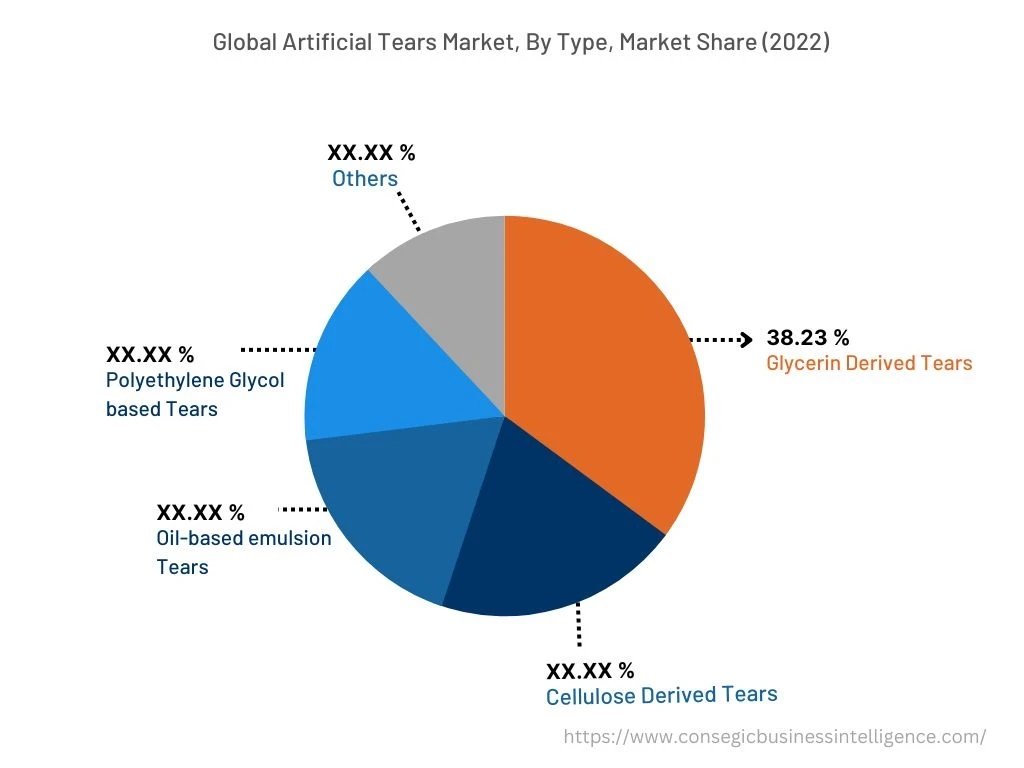
By Form :
The form segment is categorized into eye drop, ointment, spray, and others. In 2022, the eye drop segment accounted for the highest market share in the artificial tears market. The eye drop is an eye lubricant that is often deployed for relieving dry eyes. Eye drops help to comfort the burning and irritation seen in dry eyes by keeping an adequate amount of lubrication of the eyes. The government initiatives for the availability of over-the-counter artificial tear eye drops without a doctor's prescription will boost the availability of artificial tear eye drop solutions. For illustration, in October 2022, Central Drugs Standard Control Organization announced a proposal for the availability of artificial tear eye drop solutions without the prescription of doctors in India. As a result, the increasing availability of artificial tear eye drop solutions will accelerate the adoption of the above solutions for protecting the inflammation of the eyes. This factor will boost the market growth during the projected forecast period.
However, ointment is expected to be the fastest-growing segment during the forecast period because of the increasing number of eye surgeries, allergies, and others. This, in turn, is fostering the demand for these tears to ensure efficient relief for eyes, and as a result, the market for these tears is registering growth.
By Application :
The application segment is categorized into dry eye syndrome, allergies and infections, and others. In 2022, the dry eye syndrome segment accounted for the highest artificial tears market share in the upcoming years. The tears protect the dry ocular tissue from damage by lid - friction, and increase the healing of epithelial tissues and others. Furthermore, these tears are optically clear, lubricating, and soothing to the eye. The above-mentioned properties of these tears make them a perfect fit for application in dry eye syndromes. For instance, according to a recent study named National Health and Wellness Survey, in April 2020, approximately 7.4 million people in Germany were diagnosed with dry eye. The data further stated that the prevalence of dry eye has gone up by 2.7% among people in the age group of 18 to 34 years. Furthermore, the cases were 18.6% among older people. Thus, the increasing prevalence of dry eye syndrome is propelling the demand and trends for artificial tears market trends to provide protection and comfort to dry eyes. This prime determinant is augmenting the market growth.
However, the allergies and infections segment is expected to be the fastest-growing segment in the artificial tears market during the forecast period. This is due to increasing eye conditions such as inflammations, allergies to certain medications, and others.
By Region :
The regional segment includes North America, Europe, Asia Pacific, the Middle East and Africa, and Latin America.
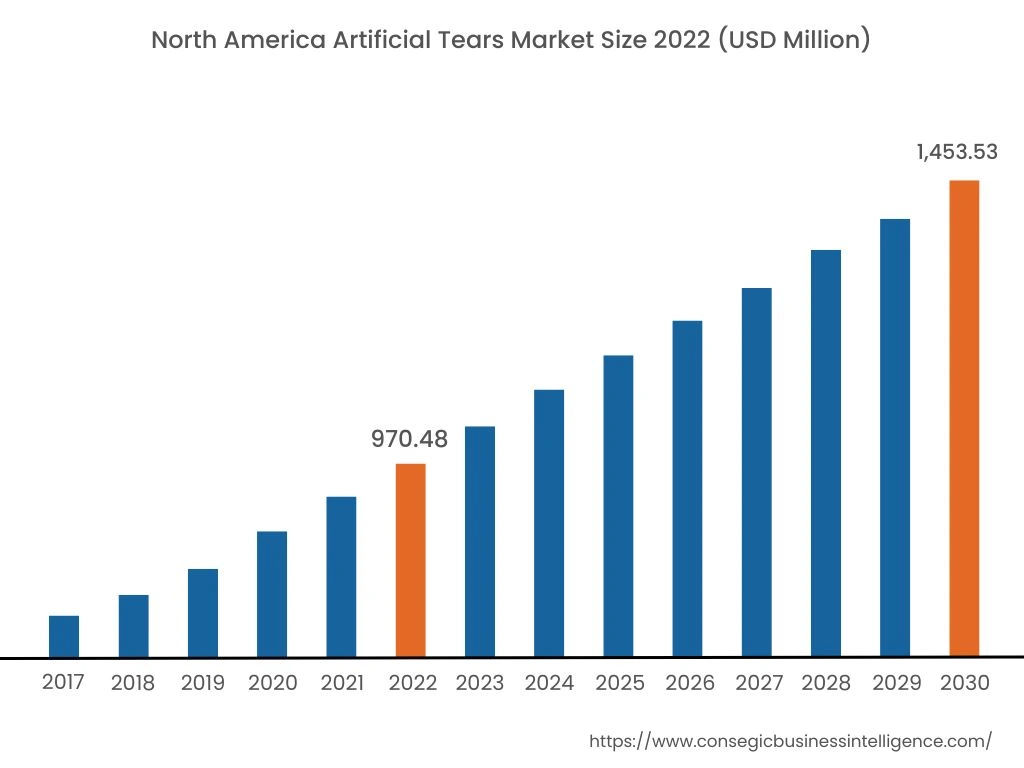
In 2022, North America accounted for the highest artificial tears market at 36.95% and was valued at USD 970.48 million, and is expected to reach USD 1,453.53 million in 2030. In North America, the U.S. accounted for the highest market share of 68.75% during the base year of 2022. Based on the artificial tears market analysis, the increasing eye-related concerns associated with old age, medical conditions, eye surgeries, and others are some of the prominent factors accelerating the adoption of these tears in the North American region. The utilization of these tears ensures protection from inflammation in the eyes. Thus, the North American players dealing in these tears products are targeting the approval of these products. For instance, in October 2022, Santen Canada Inc. announced the approval of Cationorm Plus, an tears product to relieve the symptoms of dry eyes and ocular allergies. Thus, the increasing approval of the product range in the North American region is proliferating market growth.
Furthermore, Asia Pacific is expected to witness significant growth over the forecast period, growing at a CAGR of 6.2% during 2023-20230. This is attributed to the growing demand for preservative-free tears. Therefore, the adoption of these tears is increasing in Asia Pacific for the treatment of allergies, dry eye syndrome, and others. This factor is proliferating the artificial tears market growth in Asia Pacific.
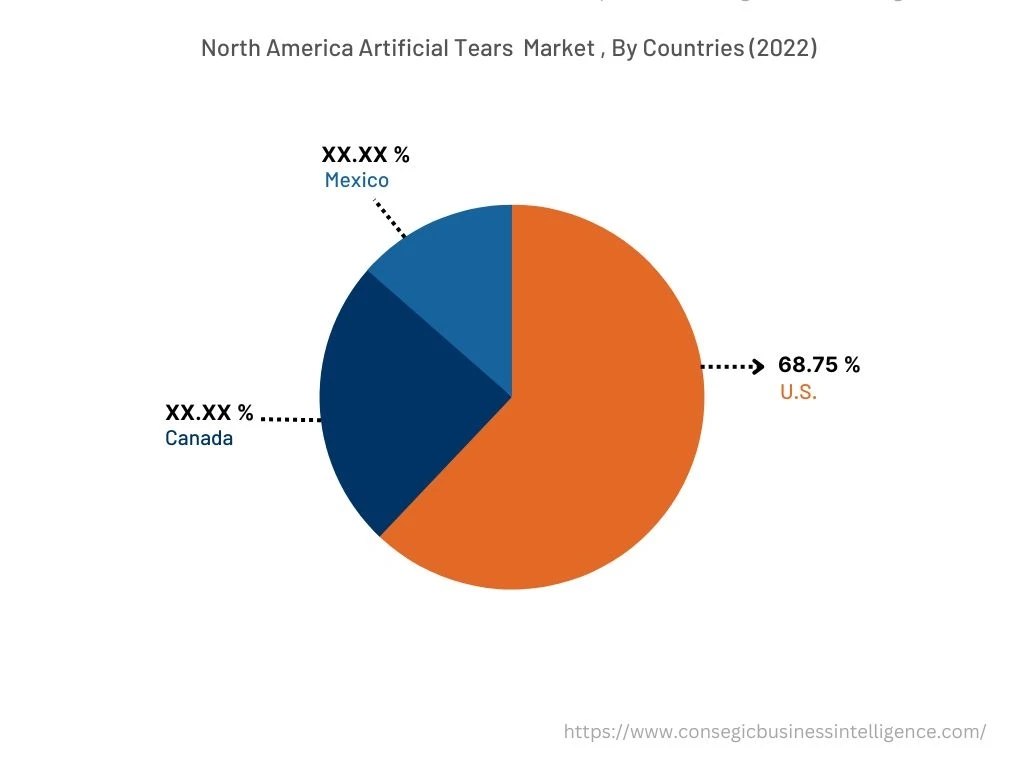
Competitive Landscape :
The global artificial tears market is highly competitive, with several large players and numerous small and medium-sized enterprises. These companies have strong research and development capabilities and a strong presence in the market through their extensive product portfolios and distribution networks. The market is characterized by intense competition, with companies focusing on expanding their product offerings and increasing their market share through mergers, acquisitions, and partnerships. The key players in the artificial tears industry include-
- Allergan
- Alcon
- Johnson & Johnson
- Nicox S.A.
- OASIS Medical
- OCuSOFT Inc.
- Santen Pharmaceutical Co. Ltd.
- Similasan Corporation
- Sun Pharmaceutical Industries Ltd.
- URSAPHARM Arzneimittel GmbH
Recent Industry Developments :
- In January 2022, Alcon, a global player in the artificial tears market launched a new product range to its European dry eye products portfolio named Systane Complete Preservative-Free Lubricant Eye Drop. The major focus of Alcon was to increase its presence in the European market.
- In July 2021, Bausch + Lomb introduced Biotrue Hydration Boost Lubricant Eye Drops for application in dry eyes. The primary aim of Bausch + Lomb was to increase the product offering for artificial tears in the global market.
- In October 20219, Allergan plc, a leading pharmaceutical company, introduced three latest ranges of artificial tears, including REFRESH RELIEVA for contacts, REFRESH RELIEVA, and REFRESH RELIEVA PF multidose. The new product line of artificial tear forms is specially formulated to minimize discomfort owing to eye dryness and to protect from further irritation.
Key Questions Answered in the Report
What was the market size of the artificial tears industry in 2022? +
In 2022, the market size of artificial tears was USD 2,626.46 million
What will be the potential market valuation for the artificial tears industry by 2030? +
In 2030, the market size of artificial tears will be expected to reach USD 3,916.83 million.
What are the key factors driving the growth of the artificial tears market? +
The increasing prevalence of dry eye syndrome is accelerating the demand for artificial tears, which, in turn, is fostering market growth.
What is the dominating segment in the artificial tears market by type? +
In 2022, the glycerin derived tears segment accounted for the highest market share of 38.23% in the overall artificial tears market.
Based on current market trends and future predictions, which geographical region will have the fastest impact on the artificial tears market's growth in the coming years? +
Asia Pacific is expected to be the fastest-growing region in the market during the forecast period.
